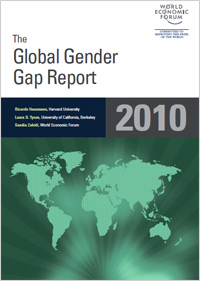This is an archive of news stories and research from the National Union of Public and General Employees. Please see our new site - https://nupge.ca - for the most current information.
Annual World Economic Forum study looks at 134 economies around the world.
 Ottawa (14 Oct. 2010) - Canada lags behind Sri Lanka, Lesotho and Latvia at No. 20 in a global ranking of equality between men and women.
Ottawa (14 Oct. 2010) - Canada lags behind Sri Lanka, Lesotho and Latvia at No. 20 in a global ranking of equality between men and women.
Nordic countries – Iceland, Norway, Finland and Sweden – ranked once again at the top of a World Economic Forum (WEF) study assessing the gender gap around the globe.
On a positive note, Canada improved its overall position somewhat from the previous year (when it had fallen to 25th place), thanks to its relative performance levels on educational attainment and economic participation.
However, Canada lags when it comes to the earning gap between men and women. The estimated earned income gap puts the country in 33rd place overall. On average, the estimated earned income for Canadian women is $28,315 compared with $40,000 for men.
A separate study released by the Toronto-Dominion Bank says the earnings wage gap is related to motherhood.
"Women in this group appear to be incurring larger wage penalties unrelated to their skills, education and experience,” the bank says. “Evidence strongly suggests that labour force intermittency is the main, yet multidimensional, culprit."
Women without children tend to have similar wages to men with comparable levels of experience and education.
Women who leave the workforce to have children tend to experience "an unexplained, but persistent" wage gap of about 3% per year for each year they are away, the bank says.
In the WEF study, the U.S. placed in the top 20 rankings for first time in the five-year history of the study. This was due to a higher number of women holding leading roles in the Obama administration in Washington as well as an improvement in the wage gap generally. France fell to 46th position with fewer women in ministerial posts.
The report ranks 134 economies according to the gap between genders. Some of the key Canadian numbers in the report are:
- 75: The labour force participation rate for women (compared to 83% for men).
- 22: Percentage of women in parliament.
- 100: Percentage of girls enrolled in primary school.
- 36: Percentage of female legislators, senior officials and managers.
- 57: Percentage of females in professional and technical worker positions.
NUPGE
The National Union of Public and General Employees (NUPGE) is one of Canada's largest labour organizations with over 340,000 members. Our mission is to improve the lives of working families and to build a stronger Canada by ensuring our common wealth is used for the common good. NUPGE
More information:
World Economic Forum - Gender Parity
